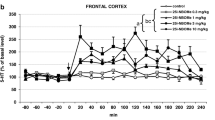Abstract
The neuropharmacological profile of 4-phenyl-1-[4-(2-naphtalimido)butyl]-piperazine (PNBP), a compound that possesses a high affinity for the serotonin receptors of 1A-type (5-HT1A) and lacks an anxiolytic action, has been studied. Intracerebral administration of PNBP to rats through implanted cannulae into the hippocampal region resulted in no substantial behavioral changes during “open field” and “conflict situation” tests, as compared with those of control animals. At the same time, the behavioral effects of intraperitoneal administration of 10 mg/kg buspirone were completely abolished if buspirone had been jointly administered with 10 mg/kg PNBP. Moreover, combined application of 0.3 mg/kg PNBP and 0.3 mg/kg 8-OH-DPAT, an agonist of 5-HT1A receptors, almost completely abolished the components of “serotonin syndrome” (prone position and stamping of the forepaws) in animals under study. These findings allowed us to conclude that PNBP has the properties of a competitive antagonist of buspirone and 8-OH-DPAT.
Similar content being viewed by others
References
S. James and P. D. New, “The discovery and development of buspirone: A new approach to the treatment of anxiety,”Med. Res. Rev.,10, No. 3, 293–326 (1990).
R. Glennon, R. A. Darmani, and B. R. Martin, “Multiple populations of serotonin receptors may modulate the behavioral effects of serotoninergic agents,”Life Sci.,48, 1493–1498 (1991).
E. Przegalinskis, E. Chojnaka-Wojcik, and M. Filip, “Stimulation of postsynaptic 5-HT1A receptors is responsible for the anticonflict effect of ipsapirone in rats,”J. Pharm. Pharmacol.,44, 780–782 (1992).
R. Kataoka, K. Shibata, A. Miyazaki, et al., “Involvement of the dorsal hippocampus in the mediation of the antianxiety action of tandospirone, a 5-HT1A agonistic anxiolytic,”Neuropharmacology,30, 475–480 (1991).
G. A. Higgins, B. J. Jones, and N. R. Oakley, “Effect of 5-HT1A receptor agonist in two models of anxiety after dorsal raphe injection,”Psychopharmacology,106, 261–267 (1992).
R. Stefanski, W. Palyko, A. Bidzinski, et al., “Serotoninergic innervation of the hippocampus andnucleus accumbens septi and the anxiolytic-like action of midazolam and 5-HT1A receptor agonists,”Neuropharmacology,32, No. 10, 977–985 (1993).
N. I. Kharin, I. V. Komissarov, and R. A. Komissarova, “Buspirone as a representative of a new class of tranquilizers,”Farmakol. Toksikol.,54, No. 3, 70–75 (1991).
P. Whitton and G. Curzon, “Anxiogenic-like effect of infusing mCPP into the hippocampus,”Psychopharmacology,100, 138–140 (1990).
S. A. Andronati, “Ligands of benzodiazepine and serotonin receptors as potential psychotropic agents,”Farmakom,10, 4–20 (1993).
S. A. Andronati, V. N. Varava, S. G. Soboleva, et al., “1-Phenyl-4-[4-(N-naphtalimido)butyl]-piperazine—a new ligand of serotonin receptors,”Dokl. Akad. Nauk Ross.,327, No. 3, 341–344 (1992).
Yu. A. Simonov, Yu. M. Chumakov, S. G. Soboleva, et al., “Molecular and crystalline structure of 1-phenyl-4-[4-(N-naphtalimido)butyl]-piperazine,”Dokl. Akad. Nauk Ukr., Ser. B, No. 2, 150–154 (1994).
T. A. Voronina, Yu. I. Vikhlyaev, L. N. Nerobkova et al., “Characteristics of pharmacological properties of phenazepam,” in:Phenazepam [in Russian], Naukova Dumka, Kyiv (1982), pp. 146–150.
M. D. Tricklebank, C. Forler, and J. R. Fozard, “The involvement of subtypes of the 5-HT1A receptor and of catecholaminergic systems in the behavioral responses to 8-hydroxy-2-(di-n-propylamine)tetralin in the rat,”Eur. J. Pharmacol.,106, 271–282 (1985).
G. N. Lakin,Biometrics [in Russian], Vysshaya Shkola, Moscow (1990).
L. G. Larsson, L. Renki, S. B. Boss, et al., “Different effects on the responses of functional pre-and postsynaptic 5-HT1A receptors by repeated treatment of rats with the 5-HT1A receptors agonist 8-OH-DPAT,”Neuropharmacology,29, No. 2, 85–91 (1990).
Author information
Authors and Affiliations
Rights and permissions
About this article
Cite this article
Karaseva, T.L., Lobasyuk, B.A., Soboleva, S.G. et al. Neuropharmacological profile of a high-affinity ligand of 5-HT1A receptors, 4-phenyl-1-[4-(2-naphtalimido)butyl]-piperazine. Neurophysiology 32, 8–11 (2000). https://doi.org/10.1007/BF02515161
Received:
Issue Date:
DOI: https://doi.org/10.1007/BF02515161




